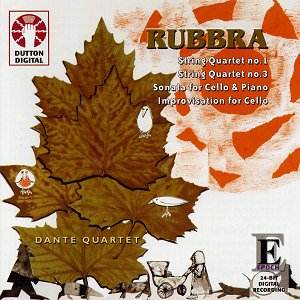Dutton Labs and producer Mike Purton are continuing
to do wonderful things on behalf of the music of Edmund Rubbra, this
being their fifth disc of his chamber music. Last year’s disc which
included the 2nd and 4th quartets was very close
to being voted as chamber music record of the year. I had a few reservations
about the Dante Quartet then but I have none this time. The only competition
to them, if the recording can still be found, is the Sterling Quartet
on Conifer (75605 51260 2). There is little wrong with the Sterling’s
version but a few comparisons need to be made. The acoustic of St. Martin’s
Church, East Woodhay is perfect for vocal music but makes the Sterlings
sound like a string orchestra lacking chamber music type intimacy. Secondly
the recording comes across as too bright - even brittle - in the high
1st Violin register, especially in the 1st quartet.
The Henry Wood Hall, as captured here, glows with the feeling of a Wigmore
Hall performance and the recorded sound is more pleasant. As to the
performances there is nothing to choose between them with regard to
the 3rd quartet except that the Sterling quartet linger longer
over the moving Adagio movement which I like. With the 1st
quartet the new-comer is preferable particularly in the middle movement
which they move on more interestingly and consequently the overall length
of the work is one minute shorter.
The first quartet is a little austere as was typical
of the composer in the ’30s, it is unusual in that Rubbra extensively
revised it (the 2nd symphony, a contemporary piece also underwent
a substantial revision) thirteen years after it first performance. It
is dedicated to Vaughan Williams whose "persistent interest in
the material led to the present revisions and additions". But I
wrote in my score when I looked through the quartet with the composer
in the early ’80s, "spot the Ravellian influences" the composer’s
own words. Incidentally VW himself was a lover of Ravel’s music having
wanted to study with him when young. If there is a touch of Ravel it
can only be found in the 1st movement with its chromaticisms;
the finale (recomposed in 1946) is typical Rubbra, in compound time,
cross-rhythms, modal, intricate and a reminder of the demonic Scherzo
of the 2nd Symphony of 1937, revised in 1950.
The 3rd Quartet as John Pickard wisely says
in the excellent and extensive booklet notes is not only a very fine
work but also one of Rubbra’s best. Each movement is connected by a
single held note and the Allegro Leggiero which ends what was up to
that point a contemplative work, is one of the most exciting and boisterous
of all Rubbra allegros.
In addition to these works we have two for the cello.
In the case of the Cello Sonata we have two alternative versions, Raphael
Wallfisch and John York (Marco Polo 8.223718) and Tim Gill and Fali
Pavri on Guild (7114) and each has its merits and none is weak. I have
to say that I have never heard the sonata in quite the way Pierre Doumenge
plays it. Movement 3 is a theme and variations (Rubbra often ended a
work with a theme and variations e.g. 3rd Symphony written
just a few years before the sonata) and he plays every note of the theme
as if it were a jewel, with incredible poise and expression and very
slowly. The movement is so romantic and deeply felt that he adds four
minutes to its length! Rubbra once commented to me, and I have written
so before, that he felt that "everyone plays my music too quickly",
so Doumenge may be on the right lines. He adds over a minute onto the
Andante moderato 1st movement also. To a certain extent the
form of the movement and flow is lost at the slower speed, but he plays
with such feeling. Ralph Scott Grover in his book on Rubbra (Scolar
Press 1993) comments that it is "one of Rubbra’s most expressive
works", and can be thought of as a cousin of the 1st
Quartet having been "written in the year that the quartet was revised
in". It was written for William Pleeth, a very passionate player,
and his wife Margaret. I once heard Rohan de Saram play the work at
the Holywell Music Room (why hasn’t he recorded it) and his approach
was similar. John York and Michael Dussek both accompany wonderfully
and so I can only advise that if possible the reader purchases both
versions, as they are so different. Or if you want a compromise then
go for Tim Gill whose playing of the middle movement is beautifully
fleet of foot.
The ‘Improvisation’ was also recorded by Gill (on ASV
DCA 1036). Here he adopts a very matter-of-fact approach treating it
as a real improvisation casting it away in less than five minutes. We
do gain a sense of the architecture but he is really a little flippant.
Doumenge is very expressive, and takes his time, over six minutes. In
truth this is not strong Rubbra, more like a chipping from the master’s
workshop but it comes off well under Doumenge and shows itself to have
some emotional power.
So to sum up although these four works have all been
recorded before, these performances rank at a very high level and the
disc, especially at medium price is a must for lovers of twentieth century
British music.
Gary Higginson


